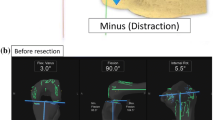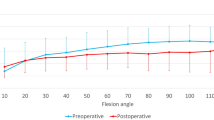Abstract
Purpose
The intra-operative femorotibial joint gap and ligament balance, the predictors affecting these gaps and their balances, as well as the postoperative knee flexion, were examined. These factors were assessed radiographically after a posterior cruciate-retaining total knee arthroplasty (TKA). The posterior condylar offset and posterior tibial slope have been reported as the most important intra-operative factors affecting cruciate-retaining-type TKAs. The joint gap and balance have not been investigated in assessments of the posterior condylar offset and the posterior tibial slope.
Methods
The femorotibial gap and medial/lateral ligament balance were measured with an offset-type tensor. The femorotibial gaps were measured at 0°, 45°, 90° and 135° of knee flexion, and various gap changes were calculated at 0°–90° and 0°–135°. Cruciate-retaining-type arthroplasties were performed in 98 knees with varus osteoarthritis.
Results
The 0°–90° femorotibial gap change was strongly affected by the posterior condylar offset value (postoperative posterior condylar offset subtracted by the preoperative posterior condylar offset). The 0°–135° femorotibial gap change was significantly correlated with the posterior tibial slope and the 135° medial/lateral ligament balance. The postoperative flexion angle was positively correlated with the preoperative flexion angle, γ angle and the posterior tibial slope. Multiple-regression analysis demonstrated that the preoperative flexion angle, γ angle, posterior tibial slope and 90° medial/lateral ligament balance were significant independent factors for the postoperative knee flexion angle. The flexion angle change (postoperative flexion angle subtracted by the preoperative flexion angle) was also strongly correlated with the preoperative flexion angle, posterior tibial slope and 90° medial/lateral ligament balance.
Conclusion
The postoperative flexion angle is affected by multiple factors, especially in cruciate-retaining-type TKAs. However, it is important to pay attention not only to the posterior tibial slope, but also to the flexion medial/lateral ligament balance during surgery. A cruciate-retaining-type TKA has the potential to achieve both stability and a wide range of motion and to improve the patients’ activities of daily living.





Similar content being viewed by others
References
Anouchi YS, McShane M, Kelly F Jr, Elting J, Stiehl J (1996) Range of motion in total knee replacement. Clin Orthop Relat Res 331:87–92
Arabori M, Matsui N, Kuroda R, Mizuno K, Doita M, Kurosaka M, Yoshiya S (2008) Posterior condylar offset and flexion in posterior cruciate-retaining and posterior stabilized TKA. J Orthop Sci 13:46–50
Arima J, Whiteside LA, Martin JW, Miura H, White SE, McCarthy DS (1998) Effect of partial release of the posterior cruciate ligament in total knee arthroplasty. Clin Orthop Relat Res 353:194–202
Bellemans J, Robijns F, Duerinckx J, Banks S, Vandenneucker H (2005) The influence of tibial slope on maximal flexion after total knee arthroplasty. Knee Surg Sports Traumatol Arthrosc 13:193–196
Bellemans J, Banks S, Victor J, Vandenneucker H, Moemans A (2002) Fluoroscopic analysis of the kinematics of deep flexion in total knee arthroplasty. Influence of posterior condylar offset. J Bone Jt Surg Br 84:50–53
Dennis DA (2001) The stiff total knee arthroplasty: causes and cures. Orthopedics 24:901–902
Ewald FC (1989) The Knee Society total knee arthroplasty roentgenographic evaluation and scoring system. Clin Orthop Relat Res 248:9–12
Fehring TK, Odum S, Griffin WL, Mason JB, Nadaud M (2001) Early failures in total knee arthroplasty. Clin Orthop Relat Res 392:315–318
Fitz W, Sodha S, Reichmann W, Minas T (2012) Does a modified gap-balancing technique result in medial-pivot knee kinematics in cruciate-retaining total knee arthroplasty? A pilot study. Clin Orthop Relat Res 470:91–98
Fukagawa S, Matsuda S, Tashiro Y, Hashizume M, Iwamoto Y (2010) Posterior displacement of the tibia increases in deep flexion of the knee. Clin Orthop Relat Res 468:1107–1114
Goldstein WM, Raab DJ, Gleason TF, Branson JJ, Berland K (2006) Why posterior cruciate-retaining and substituting total knee replacements have similar ranges of motion. The importance of posterior condylar offset and cleanout of posterior condylar space. J Bone Jt Surg Am 88(Suppl 4):182–188
Han HS, Chang CB, Seong SC, Lee S, Lee MC (2008) Evaluation of anatomic references for tibial sagittal alignment in total knee arthroplasty. Knee Surg Sports Traumatol Arthrosc 16:373–377
Harman MK, Banks SA, Hodge WA (2001) Polyethylene damage and knee kinematics after total knee arthroplasty. Clin Orthop Relat Res 392:383–393
Harvey IA, Barry K, Kirby SP, Johnson R, Elloy MA (1993) Factors affecting the range of movement of total knee arthroplasty. J Bone Jt Surg Br 75:950–955
In Y, Kim JM, Woo YK, Choi NY, Sohn JM, Koh HS (2009) Factors affecting flexion gap tightness in cruciate-retaining total knee arthroplasty. J Arthroplasty 24:317–321
Jojima H, Whiteside LA, Ogata K (2004) Effect of tibial slope or posterior cruciate ligament release on knee kinematics. Clin Orthop Relat Res 426:194–198
Joshi AB, Lee CM, Markovic L, Murphy JC, Hardinge K (1994) Total knee arthroplasty after patellectomy. J Bone Jt Surg Br 76:926–929
Kawamura H, Bourne RB (2001) Factors affecting range of flexion after total knee arthroplasty. J Orthop Sci 6:248–252
Kim H, Pelker RR, Gibson DH, Irving JF, Lynch JK (1997) Rollback in posterior cruciate ligament-retaining total knee arthroplasty. A radiographic analysis. J Arthroplasty 12:553–561
Lombardi AV Jr, Berend KR, Aziz-Jacobo J, Davis MB (2008) Balancing the flexion gap: relationship between tibial slope and posterior cruciate ligament release and correlation with range of motion. J Bone Jt Surg Am 90(Suppl 4):121–132
Lizaur A, Marco L, Cebrian R (1997) Preoperative factors influencing the range of movement after total knee arthroplasty for severe osteoarthritis. J Bone Jt Surg Br 79:626–629
Malviya A, Lingard EA, Weir DJ, Deehan DJ (2009) Predicting range of movement after knee replacement: the importance of posterior condylar offset and tibial slope. Knee Surg Sports Traumatol Arthrosc 17:491–498
Massin P, Gournay A (2006) Optimization of the posterior condylar offset, tibial slope, and condylar roll-back in total knee arthroplasty. J Arthroplasty 21:889–896
Matsumoto T, Kuroda R, Kubo S, Muratsu H, Mizuno K, Kurosaka M (2009) The intra-operative joint gap in cruciate-retaining compared with posterior-stabilised total knee replacement. J Bone Jt Surg Br 91:475–480
Matsumoto T, Mizuno K, Muratsu H, Tsumura N, Fukase N, Kubo S, Yoshiya S, Kurosaka M, Kuroda R (2007) Influence of intra-operative joint gap on post-operative flexion angle in osteoarthritis patients undergoing posterior-stabilized total knee arthroplasty. Knee Surg Sports Traumatol Arthrosc 15:1013–1018
Matsumoto T, Muratsu H, Tsumura N, Mizuno K, Kuroda R, Yoshiya S, Kurosaka M (2006) Joint gap kinematics in posterior-stabilized total knee arthroplasty measured by a new tensor with the navigation system. J Biomech Eng 128:867–871
Matsumoto T, Muratsu H, Tsumura N, Mizuno K, Kurosaka M, Kuroda R (2009) Soft tissue balance measurement in posterior-stabilized total knee arthroplasty with a navigation system. J Arthroplasty 24:358–364
Mizu-uchi H, Colwell CW Jr, Matsuda S, Flores-Hernandez C, Iwamoto Y, D’Lima DD (2011) Effect of total knee arthroplasty implant position on flexion angle before implant-bone impingement. J Arthroplasty 26:721–727
Moro-oka TA, Shiraishi H, Iwamoto Y, Banks SA (2010) Modified gap-balancing technique in total knee arthroplasty: evaluation of the post-operative coronal laxity. Knee Surg Sports Traumatol Arthrosc 18:375–380
Ostermeier S, Schlomach C, Hurschler C, Windhagen H, Stukenborg-Colsman C (2006) Dynamic in vitro measurement of posterior cruciate ligament load and tibiofemoral stress after TKA in dependence on tibiofemoral slope. Clin Biomech 21:525–532 (Bristol, Avon)
Pang HN, Yeo SJ, Chong HC, Chin PL, Ong J, Lo NN (2011) Computer-assisted gap balancing technique improves outcome in total knee arthroplasty, compared with conventional measured resection technique. Knee Surg Sports Traumatol Arthrosc 19:1496–1503
Parsley BS, Engh GA, Dwyer KA (1992) Preoperative flexion. Does it influence postoperative flexion after posterior-cruciate-retaining total knee arthroplasty? Clin Orthop Relat Res 275:204–210
Ritter MA, Harty LD, Davis KE, Meding JB, Berend ME (2003) Predicting range of motion after total knee arthroplasty. Clustering, log-linear regression, and regression tree analysis. J Bone Jt Surg Am 85:1278–1285
Ritter MA, Faris PM, Keating EM (1988) Posterior cruciate ligament balancing during total knee arthroplasty. J Arthroplasty 3:323–326
Schurman DJ, Matityahu A, Goodman SB, Maloney W, Woolson S, Shi H, Bloch DA (1998) Prediction of postoperative knee flexion in Insall-Burstein II total knee arthroplasty. Clin Orthop Relat Res 353:175–184
Schurman DJ, Parker JN, Ornstein D (1985) Total condylar knee replacement. A study of factors influencing range of motion as late as 2 years after arthroplasty. J Bone Jt Surg Am 67:1006–1014
Schuster AJ, von Roll AL, Pfluger D, Wyss T (2011) Anteroposterior stability after posterior cruciate-retaining total knee arthroplasty. Knee Surg Sports Traumatol Arthrosc 19:1113–1120
Stiehl JB, Komistek RD, Dennis DA (1999) Detrimental kinematics of a flat on flat total condylar knee arthroplasty. Clin Orthop Relat Res 365:139–148
Takatsu T, Itokazu M, Shimizu K, Brown TD (1998) The function of posterior tilt of the tibial component following posterior cruciate ligament-retaining total knee arthroplasty. Bull Hosp Jt Dis 57:195–201
Takayama K, Matsumoto T, Kubo S, Muratsu H, Ishida K, Matsushita T, Kurosaka M, Kuroda R (2012) Influence of intra-operative joint gaps on post-operative flexion angle in posterior cruciate-retaining total knee arthroplasty. Knee Surg Sports Traumatol Arthrosc 20:532–537
Victor J, Bellemans J (2006) Physiologic kinematics as a concept for better flexion in TKA. Clin Orthop Relat Res 452:53–58. Review
Zelle J, Heesterbeek PJ, De Waal Malefijt M, Verdonschot N (2010) Numerical analysis of variations in posterior cruciate ligament properties and balancing techniques on total knee arthroplasty loading. Med Eng Phys 32:700–707
Conflict of interest
No benefit in any form has been received or will be received from a commercial party directly related to the subject of this article.
Author information
Authors and Affiliations
Corresponding author
Rights and permissions
About this article
Cite this article
Fujimoto, E., Sasashige, Y., Masuda, Y. et al. Significant effect of the posterior tibial slope and medial/lateral ligament balance on knee flexion in total knee arthroplasty. Knee Surg Sports Traumatol Arthrosc 21, 2704–2712 (2013). https://doi.org/10.1007/s00167-012-2059-6
Received:
Accepted:
Published:
Issue Date:
DOI: https://doi.org/10.1007/s00167-012-2059-6




